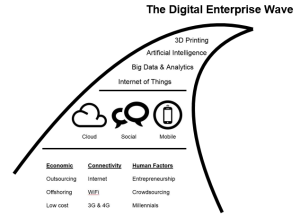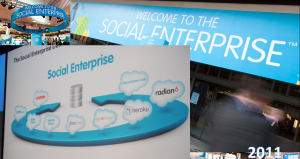I’ve spent the last 2 days at Cloud Expo Europe, the premier London based event covering cloud platforms, hybrid and multicloud approaches, cybersecurity, AI, blockchain and more, as well as well as all of the ingredients of the data centres that support those technologies. A wide set of tech topics, but within them everyone’s talking digital transformation and it’s dangerous. Dangerous because, like talking cloud 10 years ago, it means different things to different people, becoming a catch all with too much emphasis on the technology itself, rather than the business outcomes it supports. It’s the classic mistake we technology marketers have been making with our “widgets” for decades. We need to reframe the digital transformation conversation!
First, how do we define it? On the first day I was chairing the Techerati Keynote theatre. During the stand out session of the morning an audience member asked the speaker that very question. The speaker was Ian Johns, Chief Architect at Kings College London, who was talking about how you should ride the wave of digital disruption, rather than being swamped by it. A message close to the heart of us Agile Elephants! His session properly explained the disruption we are all experiencing, and he did a great job of defining digital transformation too. I’m delighted that various blogs have referenced, and the latest Cloud Industry Forum research has adopted, our own definition which is:
“Digital transformation is the process of shifting your organisation from a legacy approach to new ways of working and thinking using digital, social, mobile and emerging technologies. It involves a change in leadership, different thinking, the encouragement of innovation and new business models, incorporating digitisation of assets and an increased use of technology to improve the experience of your organisation’s employees, customers, suppliers, partners and stakeholders.”
The crucial point is that emerging technologies and innovation are driving it, but the true transformation is all about business, mindset and leadership change.

Disruptive.Live studio/stand
I spent a lot of my time at the Expo with my good friends at Disruptive.Live co-hosting some of their live #Techerati interview shows, but then switching sides and coming on as a guest to be interviewed by Will Spalding and Allan Behrens (see later). “Where are we at with digital transformation?” was the first question they asked me. So if we put the technology aside for a moment, how do you go about integrating these new approaches while running your existing business? How do you reduce risk and increase your chances of success? I believe we need to reframe the conversation. Here are my five suggestions on how to do that:
1. Encourage good behavior
Digitally savvy companies have leaders who encourage teamwork, explain their purpose with clarity, and promote an environment of openness and sharing. The particular organizational structure you have in place is less important than getting employees and leaders to embrace these behaviors. In her book The Management Shift, Vlatka Hlupic shows that many successful companies share a management style characterized by an open mindset, an unbounded culture, strong team cohesion, inspirational leaders, a strong sense of purpose, and passion for the work the company does. Check out the absolutely excellent Team of Teams by General Stanley McChrystal, Chris Fussell et al translating their experiences in Iraq War 2 to today’s complex supply chains where teamwork across organisational boundaries is crucial. These are the characteristics that 21st century leaders and managers need to be able to handle today’s rapidly changing business landscapes.
2. Think holistically
Adding mobile apps and new digital business components on top of existing systems can provide some help, and even give short-term benefits in key areas. To really transform your business, however, you need a holistic approach. According to recent Forrester research, most digitally mature businesses recognize that they must break down business silos in order to realize their digital visions. One helpful tool is the McKinsey 7-S framework, which has been tried and tested over decades. The 7-S framework emphasizes the role of coordination, rather than structure, in organizational effectiveness. First you assess the business in terms of strategy, structure, and systems. Then you examine your staff, skills, and style, as well as the shared values of the company. This approach helps to integrate all the factors needed to add value, find efficiencies, and make a real difference in your organization. You don’t have to use this particular framework, of course—there are many other useful tools out there. The point is that digital transformation becomes much easier when you think about it holistically.
3. Be agile
You need a plan to integrate your digital transformation project so that it works with your legacy systems. Your plan should draw on agile thinking while still satisfying the financial demands of the C-suite. Think in terms of short time scales and multiple iterations. Don’t fear experimentation or failure. The Forrester research already mentioned highlights agility as one of the top five metrics to measure the success of digital programmes. True agility requires you to think like a startup. First, identify the problem that needs to be solved with a new digital approach. Next, develop a minimum viable product that you can implement. Use the resulting feedback to improve and iterate your product. Pursue multiple, parallel streams of change with a six-to-eight-week cycle or shorter. Focus on achievable outcomes rather than individual tasks and steps, and be sure to foster regular communication at all levels across the process (back to Team of Teams).
4. Build a social network
True digital transformation touches all of a company’s teams and processes. You need sound cross-functional governance to get everyone on board with the disruption that’s to come. Our research shows that organizations that have implemented some form of enterprise social network or social collaboration platform, such as Workplace by Facebook, Jive, Microsoft Teams, Kahootz, GitHub or Slack, are more successful with their transformation than those that don’t. This kind of communication harnesses the collective intelligence of teams in ways that aren’t possible with old communications technologies such as e-mail.
5. Create your transformation story
Unless you are a digital native startup, your digital transformation will most likely be a complex series of incremental and strategic initiatives that fundamentally change the company over time. To get employees, customers, and investors on board, leadership needs to communicate the big idea—the “why” of what you are trying to achieve by reinventing your business. Start thinking about the principles of story telling. Start thinking in terms of the visual tools and communication processes you are going to use get the whole company as well as your partner and supplier ecosystem on board.
Here is the interview, with the answer that triggered this post. Allan and Will also ask me about Blockchain technology, and what I think of the show too:
Please check out the hashtags #techerati and #disruptivelive for more CEE19 content from this year’s show.
In summing up how to go about integrating digital transformation:
- Digital transformation requires an open mindset, an unbounded culture, strong team cohesion, inspirational leaders, a strong sense of purpose, and passion for the work the company does.
- You need agile thinking, a mix of incremental and strategic initiatives, and short development cycles.
- Leaders must communicate why they are reinventing the company so that everyone is on board with the overall goal.
- If you need help defining, adapting or communicating your particular digital transformation story, please contact us – we’d love to help.
Note – this post is an evolution of an article I wrote for enterprise.nxt the HPE Insights blog.







